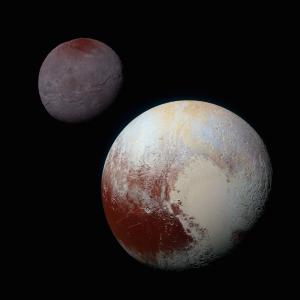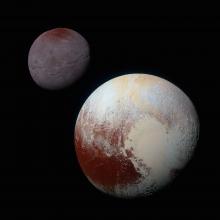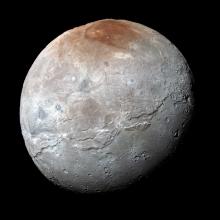Pluto and its largest moon, Charon, are shown to scale in these images from New Horizons, which flew past Pluto in 2015. Charon probably formed when the young Pluto was smashed by another large body, blasting debris into space. The debris formed a ring around Pluto, and much of it then coalesced to form Charon, which is much darker and more battered than Pluto. [NASA/JHUAPL/SwRI]
You are here
Building a World
Making a planet is complicated — even a dwarf planet. It involves pushing things together, blasting them apart, and moving them around. And it takes millions of years to finish.
Consider Pluto. It’s beyond Neptune, the outermost major planet. It’s about two-thirds the diameter of the Moon. And it has one big moon of its own, plus four little ones.
A spacecraft flew past Pluto in 2015, and a smaller object even farther out in 2019. Scientists pieced together the observations of both bodies to create a possible formation story for Pluto.
Pluto began forming more than four and a half billion years ago, in a wide, thin disk around the Sun. Tiny pebbles of ice and rock began sticking together in the outer regions of the disk. They built up into balls a few dozen miles in diameter. Some of those balls gently smushed together to make an even bigger body. As it grew, it swept up more pebbles, plus wisps of gas.
A stronger collision blasted debris from the newly forming Pluto into space, making its big moon, Charon. After that, Neptune moved farther from the Sun, into Pluto’s region. Its gravity kicked many of the big planetary building blocks farther from the Sun, so Pluto stopped growing.
Neptune’s gravity also pushed the little world farther from the Sun. And it locked Pluto and Neptune in step. The process was done in about a hundred million years — giving Pluto the basic configuration we see today.
More tomorrow.
Script by Damond Benningfield
Get Premium Audio
Listen to today's episode of StarDate on the web the same day it airs in high-quality streaming audio without any extra ads or announcements. Choose a $8 one-month pass, or listen every day for a year for just $30.






